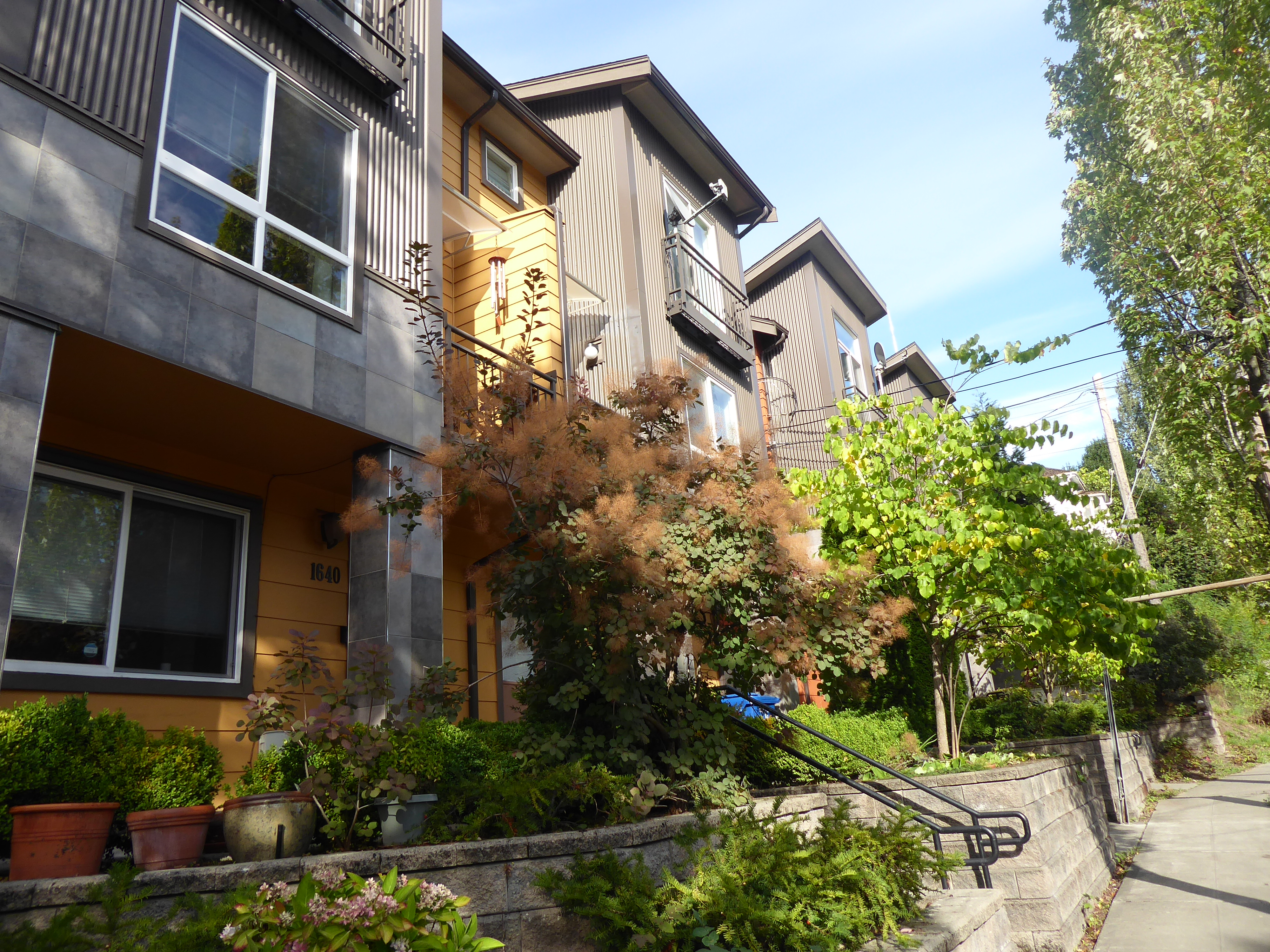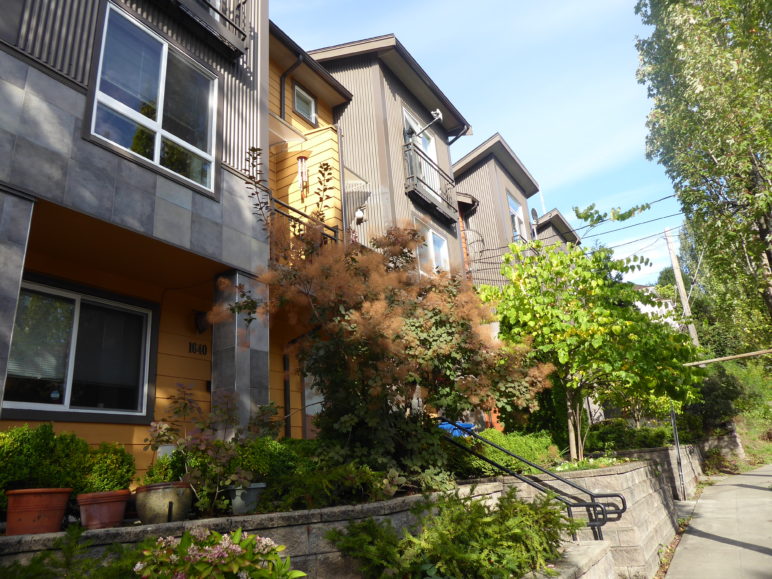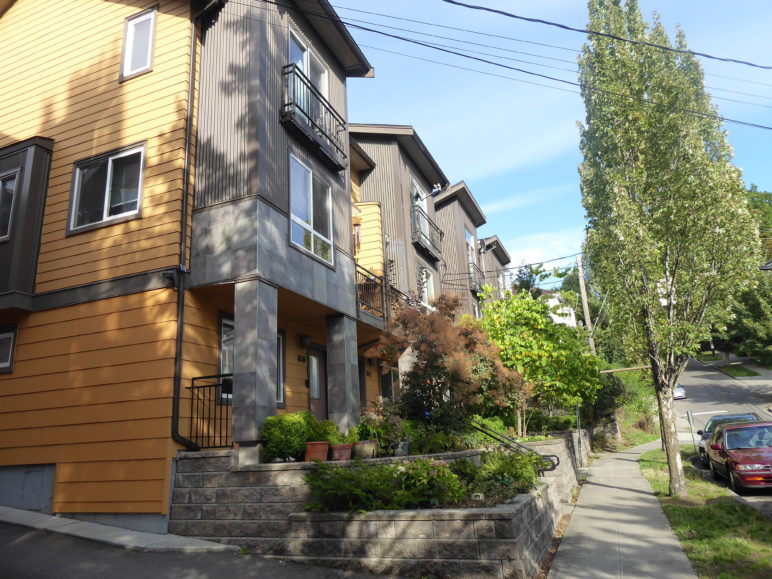The housing crisis that plagues most major cities always puts renters on the losing side as they face increasing housing instability. Rising rents and affordable housing shortages are pushing lower-income residents out of their neighborhoods in favor of the rich. One of the biggest housing policy challenges in growing cities is how to invest in low-income communities—provide walkable, amenity-rich neighborhoods with abundant and affordable housing, without displacing vulnerable residents. The preferred answer of residents and advocates has long been clear: ownership!
Unlike renters who are stuck paying whatever hike the market demands, people who own their homes can benefit from local investment.

Unlike renters who are stuck paying whatever hike the market demands, people who own their homes can benefit from local investment. As families throughout Cascadia feel the pinch of rising housing costs, more cities of all sizes are turning to the Community Land Trust (CLT) model to extend ownership opportunities across the income spectrum.
As housing advocates have long argued, CLTs halt displacement in its tracks in two main ways: they help low-income renters become owners, and they ensure permanent affordability by limiting the price at each resale. [Some CLTs also provide affordable rentals for very low-income people who can’t acquire a mortgage.] For communities under threat of displacement, CLTs can turn around a family’s fate by providing not only stable, affordable housing, but also an opportunity for wealth-building otherwise out of reach.
CLTs first cropped up in Cascadia 45 years ago, and today the region holds around 2,365 CLT homes run by 18 different CLT organizations in urban and rural communities. Nine new Cascadian CLTs are also in the works.
The region’s operating CLTs demonstrate their viability as an equitable housing solution and their potential to serve more communities. But CLTs provide a small number of homes within Cascadia, only 0.03 percent of total housing stock, which is understandable because scaling up CLT housing would require vast public investments. In Washington state, for example, the state allocated only 2.5 percent of Housing Trust Fund dollars to CLTs in 2017.
This lack of funding is the same roadblock that precludes cities from even coming close to meeting the need for other types of subsidized housing, too. On top of the cost to build homes, CLTs looking for land to take out of the private market are up against the gargantuan economic scale of real estate capitalism. Raising the share of CLT homes in a major Cascadian city to say, 10 percent, would necessitate spending billions of dollars on land alone.
In this article I present a survey of CLTs across Cascadia that testifies to the trailblazing work already accomplished and the promise of CLTs to bring stability to more Cascadians. In a follow-up I’ll explore the barriers to scaling up CLTs and solutions for overcoming them.
What is a CLT?
CLTs are non-profit corporations that acquire land and develop housing, which they sell at below-market rates. CLTs typically serve low- to moderate-income households earning 50 to 80 percent of the area median income (AMI). Some CLTs also provide affordable rentals, typically serving low-income households. In Cascadia, most CLTs offer ownership and rental homes.
For ownership, the CLT owns the land and the resident owns the home, with use of the land granted through a 99-year ground lease. CLTs restrict the price at each sale using a variety of formulas, such as fixed-rate, appraisal based, or AMI based. These caps typically limit appreciation to 1.5-2 percent annually. In most cases, owners acquire less equity over time than would the owner of an unrestricted home.
Critics argue that because CLTs limit the accrual of equity, they create a “second-class” of homeowners, compared with owners of market-value homes. But for those who cannot access the traditional housing market, ownership with less equity is better than no ownership at all. The equity built in a CLT home can sometimes help CLT owners to purchase a home on the open market. For example, according to representatives of Proud Ground CLT in Oregon, of the 15% of homeowners who sell their home, 54% of their homeowners go on to purchase their own home.
Compared with standard subsidized rentals, CLTs can offer greater permanence, using a one-time subsidy to preserve long-term affordability. By perpetually restricting resale of the home, the CLT preserves the initial subsidy over time. In contrast, subsidized rental projects often require ongoing funding to cover operating expenses, and many can also be at risk of market-rate conversion when federal tax credits expire.
The birth and growth of CLTs
In 1969, a group of Black farmers and civil rights activists in Albany, Georgia, founded New Communities Inc., which was the first CLT in the United States or Canada. They created it to help Black farmers facing threats of eviction due to their participation in the civil rights movement. From its inception, the CLT’s mission was to help Black residents stay rooted in their communities and protect against displacement.
Today, depending on who’s counting, there are somewhere between 225 and 300 CLTs nationwide in the United States, the largest being the Champlain Housing Trust in Vermont with 2,765 homes. American CLTs are predominantly concentrated in the Northeast, but Cascadia has a growing CLT network dating to the late 1980s.
Most CLTs begin through community-focused or affiliated groups such as neighborhood associations, community organizers, community development corporations (CDCs), or religious coalitions. When starting a CLT, organizers typically seek buy-in from the low-income community the CLT would serve, and support from government agencies, nonprofit organizations, housing industry advisors, local businesses, and banks. To move from idea to reality, CLTs must raise funds for land acquisition, development, and operations.
Under the classic model, a CLT is governed by its members, which can include current and future residents, community members, and general representatives (public officials, local funders, local housing/social service providers, etc.). The members elect a governing board, which usually includes a balanced representation of CLT residents, community members, and general representatives, giving all stakeholders a voice in determining the CLT’s future.
CLTs in Cascadia
Sightline defines Cascadia as encompassing Washington, British Columbia, Idaho, and Oregon, as well as small parts of Montana and California, and southern Alaska. Similar to much of North America, many communities across Cascadia are facing a housing crisis. Nationally, 47 percent of renters are cost-burdened, spending over 30 percent on housing costs. Some 46 percent of renters in Washington spend 30 percent or more of their income on housing, as do 49 percent in Oregon, and 42 percent in both Idaho and British Columbia. Among renter households earning less than $50,000 per year, 77 percent spend 30 percent or more of their income on housing in Washington, as do 76 percent in Oregon, 65 percent in Idaho, and 71 percent in British Columbia.
For over four decades, Cascadian CLTs have been safeguarding residents against rising home prices. The region’s first was the Evergreen Land Trust, founded in 1974, which includes four cooperative homes and three farms.
Today, CLTs provide an estimated 2,365 affordable homes in Washington, Oregon, Idaho, and British Columbia. These homes are a promising achievement, but they represent just 0.03 percent of the region’s 7.5 million homes, which does not address the need for permanently affordable housing.
Cascadia’s largest CLTs are located in its three largest cities: Seattle, Vancouver, and Portland. Seattle’s Homestead Community Land Trust, Portland’s Proud Ground Community Land Trust, and Vancouver Community Land Trust make up 64 percent of the region’s CLT homes. Homestead operates 215 homes and Proud Ground operates 280.
Vancouver’s Community Land Trust, by far the largest in the region, has 1,000 CLT homes and plans to construct 1,700 more—a production rate far outpacing other CLTs in Cascadia. That past success and high rate of future growth arose from unique local circumstances: a strong partnership with the city, a history of co-op conversion to CLTs, leased city-owned land on which to build, and a large, established, quasi-governmental organization capable of building and managing a big stock of CLT homes.
In terms of the number of CLT organizations, Washington currently leads the Cascadian pack with 17. Idaho has two CLTs; Oregon, three; and British Columbia, four. CLT capacity and pricing varies by location. In general, compared with rural CLTs, urban CLTs tend to have more units and higher prices that reflect more expensive local housing markets.
See the table below for a rundown of all of Cascadia’s CLTs:
Name of CLT |
Est. number of homes |
Location |
| Community Land Trust Foundation | 1,000 | Vancouver, British Columbia |
| Proud Ground | 280 | Clackamas, Clark, Lincoln, Multnomah, and Washington counties in Oregon and Washington |
| Homestead CLT | 215 | King County in Washington |
| Kulshan CLT | 138 | Bellingham, Washington |
| OPAL CLT | 135 | Orcas Island, Washington |
| Housing Resources Bainbridge | 131 | Bainbridge Island, Washington |
| Vashon Household | 114 | Vashon Island, Washington |
| Vernon & District CLT | 81 | Vernon, British Columbia |
| Home Trust of Skagit | 58 | Skagit County in Washington |
| Lopez CLT | 48 | Lopez Island, Washington |
| San Juan Community Home Trust | 37 | San Juan Island, Washington |
| NeighborWorks Umpqua CDC | 30 | Ashland, Oregon |
| Arch Community Housing Trust | 26 | Blaine County in Idaho |
| Salt Spring Community Housing & Land Trust | 24 | Salt Spring Island, British Columbia |
| SHARE CLT | 20 | Leavenworth, Washington |
| Evergreen Land Trust | 14 | King, Snohomish, Skagit, and Whatcom counties in Washington |
| Sabin CDC | 14 | Portland, Oregon |
| Homeward Bound | 5 | Clallam and Jefferson counties in Washington |
| Methow Housing Trust | 5 | Mazama, Winthrop, and Twisp, Washington |
| Total | 2,365 |
There are also 9 Cascadian CLTs that do not have homes yet: Africatown CLT (WA), Chelan Valley Housing Trust (WA), Hogan’s Alley Land Trust (BC), Homes and Hope CLT (WA), Kor CLT (OR), Moscow Affordable Housing Trust (ID), Spokane CLT (WA), Thurston County Land Trust (WA), and Waldron CLT (WA).
CLTs have inspired other housing providers, like Habitat for Humanity, to use the CLT ground lease and affordability requirements to provide permanently affordable housing. For example, Habitat’s King County chapter provides over 160 permanently affordable homes. Other Habitat chapters in Washington, Oregon, and Idaho work in partnership with CLTs or established their own land trusts, which don’t typically operate under the classic CLT model.
How do CLTs operate in Cascadia?
Kulshan CLT homes are typically $50,000 to $100,000 less than the price of market-rate homes in Bellingham, and two of its rentals serve households with incomes 50 percent below AMI. OPAL CLT serves low-income residents on Orcas Island located in San Juan County, an area with Washington’s highest affordability gap. Homestead alone accounts for nearly a quarter of CLT homes in Washington, and a majority of its homeowners are people of color.
Following in the tradition of the New Communities CLT in Georgia, Sabin CDC in Portland, Africatown CLT in Seattle, and Hogan’s Alley Land Trust in Vancouver aim to restore the historically Black neighborhoods in Northeast Portland, the Central District in Seattle, and Hogan’s Alley in Vancouver. As all three cities become increasingly expensive and exclusive, these efforts will help ensure that Black residents, business owners, and communities across the African diaspora can maintain roots in their neighborhoods.
Since 1991, Sabin CDC has provided affordable housing across Northeast Portland, where the city’s historically Black neighborhoods are concentrated. The CDC includes a land trust, the first in Portland, which provides 14 homes and a majority of their homeowners are people of color. Africatown CLT in Seattle has started design work on its first project, a mixed-use apartment building called Africatown Plaza*, which will provide 134 homes renting at 60 percent AMI or below. Hogan’s Alley Land Trust is negotiating with the city of Vancouver to develop up to 550 rental homes on city-owned land in Hogan’s Alley that will be vacated after the city removes the Georgia Viaduct that runs through Hogan’s Alley, which displaced the historic heart of the Black community and parts of Chinatown in the late sixties.
Through its Hub and Spoke program, Proud Ground expanded from its initial focus on Portland to communities across Clackamas, Clark, Lincoln, Multnomah, and Washington counties. The program creates partnerships with non-profit housing providers to assist them in developing CLT homes of their own. The Hub and Spoke program has 208 units in the pipeline, 158 of which will become part of Proud Ground’s portfolio, with the rest going to non-profit partners.
CLTs first came to Canada in the late 1970s and early 1980s, utilized as a way to preserve the affordability of housing co-ops, in which the federal and provincial governments heavily invested during the urban renewal period in the sixties. The CHFBC’s 1,000 CLT homes differ from the most common CLT model in two ways: First, they are strictly multifamily apartments and townhomes—not detached houses. Second, residents hold ownership through a co-op arrangement, which means they share ownership of the entire multifamily building, not just the unit they live in.
The high production rate is largely the result of a partnership with the city of Vancouver. Beginning in 1993, the CHFBC’s CLT operated co-ops on lands owned by the BC government, which later transferred ownership to the CLT. In 2012, the city of Vancouver partnered with the CHFBC to produce 358 new affordable homes on city surplus land. Building on that momentum, CHFBC’s CLT has acquired 275 more homes since 2012, along with the 1,700 in the pipeline.
What will it take to scale up CLTs?
CLTs have fostered community-controlled affordable housing in select Cascadian communities. Today, the region’s 18 operating CLTs and 2,361 homes demonstrate that they can be a viable way to deliver housing security for low-income people. Their numbers are large compared with where they started 30 years ago, but they remain a fraction of one percent of Cascadia’s dwellings. Why don’t we see more of them?
The main barrier is lack of funding. In a follow-up to this article, I’ll examine funding barriers and suggest solutions for boosting the production of CLT homes.
Note:
*Africatown CLT previously partnered with Capitol Hill Housing to convert the Liberty Bank building into affordable housing. The Liberty Bank Building is owned by Capitol Hill Housing as the developer, and after a 15 year tax credit compliance building, Africatown Community Land Trust and Byrd Barr Place have a right of first refusal to own the building.
Update, Sept. 27: This article has been updated to include data from Sabin Community Development Corporation’s CLT stock.
Update, Sept. 30: This article has been updated to include information about Habitat for Humanity’s land trust homes.
Update, Oct. 25: An earlier version of this article stated that the first Cascadian CLT was Lopez CLT, which was the first to operate under the classic CLT model involving income and resale restrictions.
Acknowledgements: Thanks to Kathleen Hosfeld with Homestead Community Land Trust for providing key insights on CLT practices and initial data on CLTs in Washington and Oregon. Thanks to Jackie Keogh at Proud Ground, Brian Shelton-Kelley at NeighborWorks Umpqua Community Development Corporation, Stephanie Allen at Hogan’s Alley Land Trust, Tamara White at Community Land Trust in Vancouver, Michelle Griffith at Arch Community Housing Trust, Nils Peterson at Moscow Affordable Housing Trust, Kendra Meyer at Kulshan Community Land Trust, and Loulie Brown at Sabin CDC for sharing their CLT expertise and providing information about their organizations. Thanks to Jenee Gaynor and Vince Wang at Grounded Solutions Network for their insights into the national and regional CLT movements.












Garlynn Woodsong
Why no mention of Sabin CLT? In NE Portland, heavily focused on serving POC…
Nisma Gabobe
Hi Garlynn,
Thanks for alerting me to the fact that Sabin Community Development Corporation has homes under the CLT model! I am getting confirmation on the number of CLT homes they have and will add that information to the article. Thanks again!
Aid Gab
I am impressed by the this article.
Mia Walterson, Program Director
Nisma,
This is interesting data, thanks for putting it together! I wanted to add that while Habitat for Humanity Seattle-King County does not fit the “classic” definition of a Community Land Trust we have a land trust program that includes the permanent affordability elements – including the FMNV model ground lease – used by CLTs. Currently, we have 160+ homes in our land trust portfolio and are committed to using this model in our future homes. Thanks again for your article – it’s great to know the message of permanent affordability is catching on!
Nisma Gabobe
Hi Mia,
Thanks for sharing this information about Habitat’s land trust homes in King County! I’ve updated the article to include that Habitat for Humanity operates some land trusts.
Thanks,
Nisma
Mary Vogel
Nisma,
Do you think it would be constructive to take a page from AOC : “It’s time that we stop commodifying the housing market, because it is not a speculative investment, it is a basic right for all Americans,” said Ocasio-Cortez at the launch of CPD’s “A Home To Thrive” campaign on September 10.
Don’t we have to decide between wealth-building through home ownership and de-commodifying housing? While there’s alot to like in your article, I especially take issue with this citation from Proud Ground
“The equity built in a CLT home can sometimes help CLT owners to purchase a home on the open market. For example, according to representatives of Proud Ground CLT in Oregon, of the 15% of homeowners who sell their home, 54% of their homeowners go on to purchase their own home.”
Frankly, I believe that the sooner we start to see CLT as a whole new system of land tenure in America–a system that is meant to replace the existing system–the sooner we will get to that de-commodification that I have long called for. I’m so happy to see AOC joining the chorus. I called for Bernie to do so in his 2016 run http://plangreen.net/housing-affordability-put-a-bern-on-it/, but he refused to budge from his script.
Jan Steinman
While not formally a CLT, EcoReality Co-op is seeking others who wish to do collaborative farming through the co-op ownership model.
We are planning eleven units of affordable equity housing for those who want to do collaborative agriculture. We limit equity growth to the Consumer Price Index (inflation), so, while you won’t get rich from joining us, you’ll be able to plant walnut trees for your grandchildren to enjoy.
Paula Kuttner
The need for affordable housing seems greater all the time– everything we can do toward this goal helps!
Audrey Dumentat
I went searching for the follow-up article you refer to at the end of this one – on funding barriers and solutions. I couldn’t find it in the internet. Can you please send me a link?
Carmen Jackson
Do community land trust help homeowners with there mortgage in any way of catching up r lowering monthly payment my name is ms jackson my email carrollcarmen46@yahoo.com / phone # 510 4231409 I was denied loan modification by wells fargo 4 times my monthly income. Is 5400 which they say is not enough for modification I up for all suggesting thanx
Meadoe Nyberg
Hello, how do I found out more information about applying to these land trusts in Washington? I am interested particularly in the Leavenworth, WA one. Thank you.